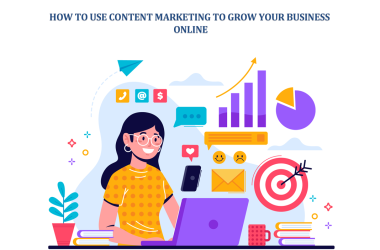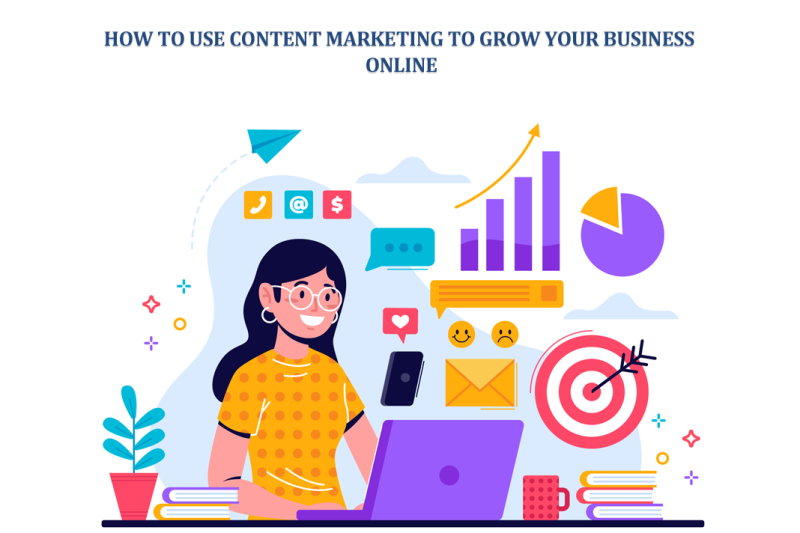Can words really grow a business? Sounds crazy, right? But they can. Words build bridges. They connect strangers. They turn cold clicks into warm customers.
Think about it. You read a post. It hits home. You feel seen. You click. You trust. That’s the silent force of content marketing. It’s not screaming “buy now.” It’s whispering, “I get you.”
The internet’s loud. Everyone’s selling. But not everyone’s listening. Content marketing is part strategy part storytelling, and when done right it doesn’t just sell. It sticks.
Let’s walk through how you can use content marketing to grow your business online. Slowly. Smartly. Authentically.
What is Content Marketing?
Forget the buzzwords. Content marketing is simple. You give before you take. You teach before you sell.
It’s blogs, videos, podcasts, reels, whatever. But it’s more than formats. It’s about value. You’re not shouting offers; you’re solving problems.
Think of it as planting seeds. You post a blog today. Someone reads it tomorrow. They remember you next week. They buy next month. That’s the game. Slow, but steady.
Content isn’t just content. It’s trust in disguise. Every piece you publish adds another layer to your brand’s credibility.
The trick? Be useful. Be honest. Be real. People can smell fake from miles away.
1. Know Your Audience. Deeply.
Here’s the thing—you can’t talk to everyone. You’ll end up reaching no one.
Picture your ideal customer. What do they worry about at 2 a.m.? What excites them? What frustrates them? The deeper you know them, the easier it is to write for them.
Data helps—Google Analytics, social insights, surveys. But don’t forget your gut. Feel what your audience feels.
Create audience personas. Give them names. “Sara, the freelancer.” “Ahmed, the small shop owner.” Makes it easier to connect.
Because content that connects isn’t written to people. It’s written for them. Big difference.
2. Goals. Without Them, You’re Lost.
You can’t just post stuff and hope magic happens. You need direction.
What’s your goal? Traffic? Engagement? Sales? Each one needs a different approach.
If you want awareness create shareable posts. If you want sales write detailed product guides. If you want loyalty build an email list.
And measure it. Always. Views, clicks, conversions. Data tells stories. You just have to listen.
Without clear goals, even great content gets lost in the noise.
3. Create Content That Talks, Not Shouts
People scroll fast. You have seconds. Maybe less. So, grab attention quick.
Start with a killer headline. Something that makes them stop. Then, keep them reading with short, snappy lines.
Stories work best. Always. Tell how your brand started. Share a customer’s win. Talk about your failures too. People relate to imperfection more than perfection.
Mix it up. Blogs. Reels. Infographics. Podcasts. Variety keeps things fresh.
Don’t overcomplicate your language. Keep it real. Keep it simple. Talk like you’d talk to a friend. Because business is personal now.
4. SEO: The Backbone You Can’t Ignore
You can write the best piece ever but if no one finds it, what’s the point?
That’s where SEO steps in. It’s your silent partner. The one working behind the scenes.
Do keyword research. Find what people search. Use those words smartly in your titles and paragraphs. But don’t force them. Google knows when you’re trying too hard.
Add links. Internal ones, external ones. Make your site a web of helpful info.
Use clear headings. Optimize your images. Keep your site fast. Slow websites lose attention faster than bad writing.
SEO isn’t just for algorithms. It’s for real people trying to find real answers.
5. Social Media: The Megaphone for Your Voice
You wrote something amazing. Now what? Share it. Everywhere your audience hangs out.
Instagram. LinkedIn. TikTok. Facebook. Each platform has its own personality. Match the tone.
Don’t just dump links. Engage. Ask questions. Reply to comments. Start conversations. That’s where the magic happens.
Show your human side. Post behind-the-scenes clips. Share funny bloopers. Tell mini-stories. People buy from humans, not logos.
Social media isn’t just promotion. It’s connection. Use it to build your tribe, not just your traffic.
6. Consistency Builds Trust
You can’t post once and vanish for months. That’s how trust dies.
Show up regularly. Weekly blogs. Daily stories. Monthly newsletters. Whatever works just be consistent.
Keep your tone steady. If you sound warm in one post and robotic in the next, people get confused.
And don’t fake perfection. Share real moments. The messy, honest ones. People respect that more than polished sales talk.
Consistency isn’t about frequency. It’s about reliability. Be there. Every time.
7. Email Marketing: The Old Tool That Still Works
Emails. The quiet warriors of marketing. Old-school but unbeatable.
It’s direct. Personal. Private. You land straight in someone’s inbox. That’s powerful.
Start by building your list. Offer something useful—a guide, discount, or checklist. Use tools that make sign-ups easy. A WooCommerce Registration Plugin works great for online stores. Smooth process, happy users.
Then, nurture your subscribers. Don’t just sell. Share stories. Tips. Behind-the-scenes notes. Build a relationship.
Make it personal. Use their names. Suggest things they’d actually want. The small details matter.
Email marketing isn’t about numbers. It’s about connections.
8. Measure What Matters
You can’t grow what you don’t track.
Check your analytics often. What’s working? What’s not?
Maybe your videos get more views than blogs. Or maybe your “how-to” guides bring the most sign-ups. That’s data talking.
Use tools like Google Analytics or HubSpot. They show patterns. Behavior. Insights.
Don’t chase vanity metrics. Likes don’t always equal sales. Focus on what moves your business forward—clicks, leads, conversions.
Adjust. Improve. Repeat.
9. Repurpose Everything You Can
Good content shouldn’t die after one post. Reuse it.
Turn a blog into a carousel post. Turn a podcast into short clips. Convert stats into infographics.
Old blogs? Update them. Add new info. Refresh the SEO. Give them new life.
Repurposing saves time and keeps your feed active. It’s smart, not lazy.
One idea can fuel ten different formats if you’re creative enough.
10. Collaborate and Grow
Partnerships speed up growth.
Find influencers or creators in your niche. Not the biggest ones—the real ones. The ones with loyal audiences.
Collaborate on posts, podcasts, or campaigns. You tap into their followers. They tap into yours. Win-win.
Also, connect with experts. Interview them. Quote them in your blogs. Their credibility adds weight to your words.
In the online world, collaboration isn’t competition. It’s evolution.
11. Turning Readers into Buyers
All this content. But where’s the sale? Don’t worry it’ll come.
Use subtle calls to action. Don’t beg. Invite. “Learn more.” “Join us.” “Try now.” Keep it simple.
Create landing pages for your offers. Add reviews, visuals, short forms.
12. Stay Ahead of the Game
Marketing moves fast. Blink and trends change.
Keep learning. Read blogs. Watch webinars. Try new tools.
AI, short videos, user-generated content new waves come every month. Ride them early.
But don’t follow trends blindly. Your audience will tell you what works better than any algorithm.
Stay flexible. Stay curious. Stay brave.
Conclusion
Content marketing isn’t just another strategy. It’s your story told right.
Every post, every email, every video—it’s a small piece of your brand’s soul floating online. Over time, they connect. They create something bigger—trust.
And trust? That’s gold. It turns strangers into fans. Fans into customers. Customers into loyal supporters.
Don’t overthink it. Start small. Be real. Keep going.
Let your content speak when you’re silent. Because in the end, words when they’re honest don’t just sell. They stay. They grow. They build something real.
That’s how businesses grow online. One story. One post. One honest connection at a time.










